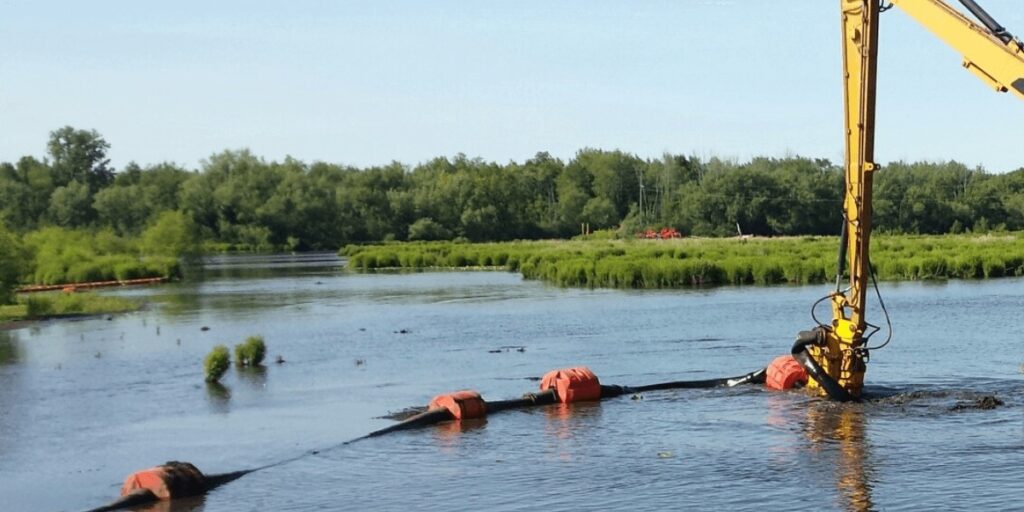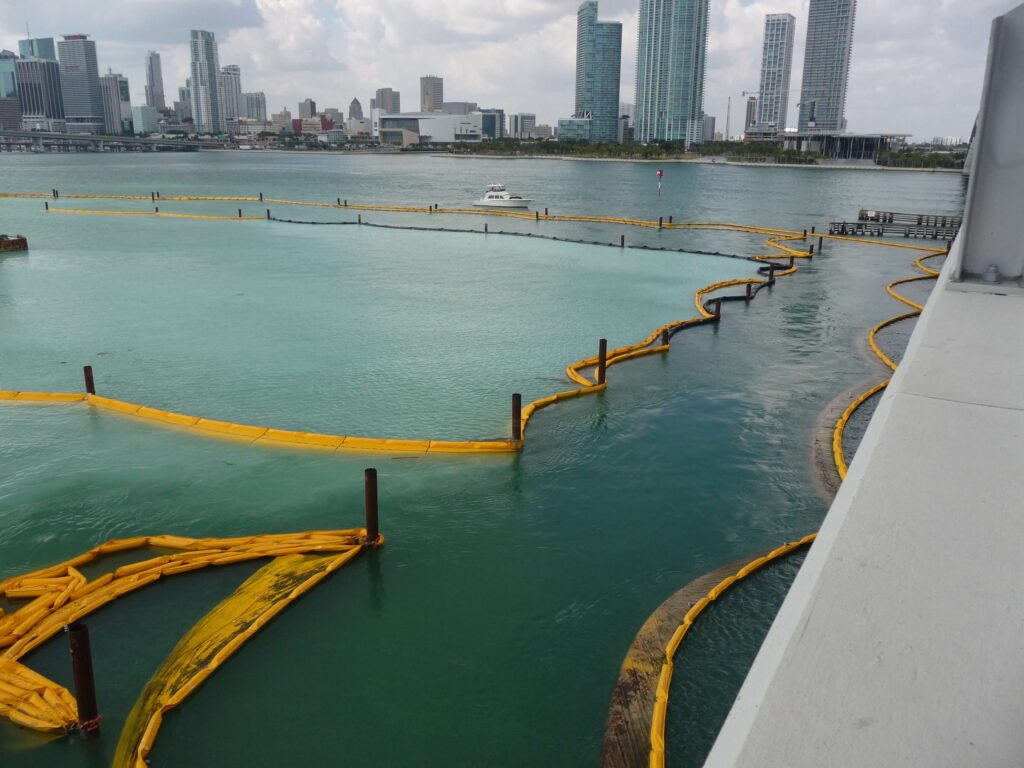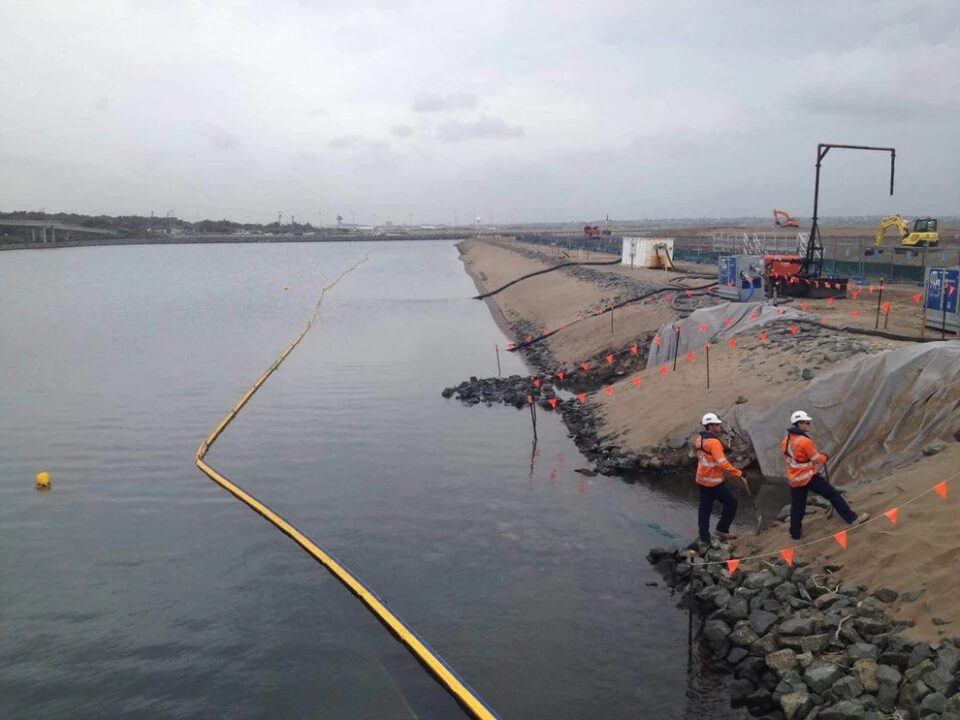Dredging plays a vital role in maintaining waterways, harbours, and marinas by removing sediment build-up and keeping navigation routes safe.
However, this essential activity can also disturb large quantities of fine sediment, creating cloudy plumes that threaten aquatic ecosystems.
Controlling this disturbance is therefore critical for both environmental protection and compliance with local regulations.
To address this challenge, Silt curtains — also known as turbidity curtains, silt barriers, or silt booms — have become an indispensable solution.
These floating barriers prevent sediment from spreading, ensuring that dredging and construction activities can proceed responsibly while preserving the surrounding marine environment.
How Dredging Pollutes Our Waterways

While dredging is essential to deepen channels, remove debris, and maintain harbour access, it can unintentionally release massive amounts of fine particles into the water column.
The same effect occurs during other marine and coastal construction works such as pile driving, reclamation, or laying underwater pipelines.
These activities can quickly create a sediment plume — a dense cloud of particles that drifts through the water, reducing visibility and disrupting the delicate balance of aquatic ecosystems.
Without proper containment, sediment plumes can travel far beyond the construction zone, impacting seagrass beds, coral reefs, and coastal wetlands.
This not only harms marine biodiversity but also affects local fisheries, tourism, and community livelihoods.
Physical Pollution of Waterways
One of the main consequences of dredging is physical pollution. When fine sediment — such as silt, clay, or organic matter — becomes suspended in the water, it increases turbidity.
This murky water reduces the amount of sunlight that can penetrate the surface, which in turn interferes with photosynthesis in underwater vegetation like algae and seagrasses.
These plants form the foundation of many marine food webs, and their decline can cascade through the ecosystem.
Furthermore, when the suspended sediment eventually settles, it can smother the seabed. Corals, shellfish, and other benthic (bottom-dwelling) organisms can be buried, suffocating entire habitats and reducing biodiversity.
Over time, this sedimentation leads to habitat degradation and ecological imbalance.
Here, silt barriers act as a preventive measure — they confine disturbed materials within a designated zone, allowing particles to settle naturally in a controlled area. This minimizes the spread of turbidity and protects nearby habitats.
Chemical Pollution of Waterways

Sediment pollution is not only a visual or physical problem. Many seabed sediments contain chemical pollutants such as heavy metals, hydrocarbons, and nutrient compounds that have accumulated over time. When dredging disturbs these layers, contaminants can be reintroduced into the water, posing toxic threats to aquatic organisms and even humans.
Elevated nutrient levels, particularly nitrogen and phosphorus, often trigger harmful algal blooms (HABs). These blooms deplete oxygen from the water, leading to massive die-offs of fish and other marine life.
By isolating and containing disturbed sediment, turbidity curtains reduce the risk of these contaminants spreading into surrounding waters, supporting cleaner and safer aquatic conditions.
How Silt Curtains Work
The design of silt curtains is both simple and highly effective. They consist of a floating boom on the surface and a vertical, weighted skirt made of geotextile fabric that hangs below.
This structure forms a continuous barrier that extends from the surface down toward the seabed. Anchors and tension lines keep the curtain securely in place, even under the influence of currents and waves.
As dredging stirs up sediment, the Silt curtains prevent the particles from dispersing beyond the work area. Within this enclosed zone, sediment gradually settles back onto the seabed instead of drifting into open waters.
Depending on the project conditions, silt curtains can be customized — they vary in skirt depth, fabric permeability, and structural reinforcement. Shallow and calm water applications may use lightweight curtains, while offshore dredging or tidal estuaries require more robust, heavy-duty designs capable of withstanding strong hydrodynamic forces.
Applications of Silt Curtains

Silt curtains are widely adopted across both marine and civil engineering sectors. Their primary applications include:
- Dredging and Reclamation Projects: Containing sediment stirred up during harbour deepening, land reclamation, or beach nourishment operations.
- Bridge, Jetty, and Pier Construction: Preventing sediment migration during foundation drilling, pile driving, or excavation near sensitive ecosystems.
- Underwater Pipeline and Cable Installation: Reducing sediment disturbance during trenching or burial operations.
- Environmental Remediation: Isolating contaminated sediments during cleanup activities to prevent recontamination of nearby waters.
- Stormwater and Coastal Management Projects: Serving as temporary control barriers to limit sediment discharge during construction.
Their ease of deployment, cost-effectiveness, and proven performance make silt curtains a preferred choice among contractors and environmental engineers alike.
Properly installed, they not only ensure regulatory compliance but also help companies demonstrate environmental responsibility.
Design Considerations and Best Practices
When planning a dredging project, selecting the right type of silt curtain depends on various factors, including water depth, current velocity, tidal conditions, and expected sediment load.
Engineers must also account for wind exposure, anchoring needs, and maintenance accessibility.
It’s important to conduct a pre-installation site assessment to determine the ideal configuration. During operation, regular inspections should be performed to ensure the curtain remains properly tensioned, with no tears or gaps that could allow sediment to escape.
After project completion, curtains should be carefully removed and cleaned for reuse, minimizing waste and cost.
Training personnel on correct deployment and maintenance is equally essential. Improper installation — such as placing the curtain too deep, too shallow, or without secure anchoring — can compromise effectiveness and even cause environmental harm if the barrier collapses or drifts away.
Protecting Marine Environments Through Responsible Practice
Although silt curtains might seem like a straightforward technology, their role in sustainable marine construction is vital. By effectively controlling sediment dispersion, they help safeguard fragile ecosystems, promote biodiversity, and maintain water quality.
From small harbours to massive dredging operations, turbidity curtains embody the principle of responsible engineering — balancing progress with environmental stewardship.
With growing awareness of climate and habitat preservation, these barriers are not just regulatory tools but symbols of a collective effort to build and maintain our coastal infrastructure responsibly.
Through the consistent and correct use of Silt curtains, we can continue to improve our waterways while ensuring that the life beneath the surface thrives for generations to come.

